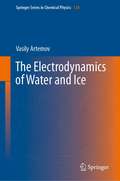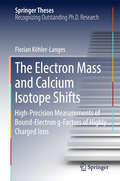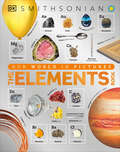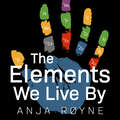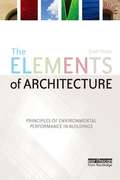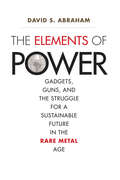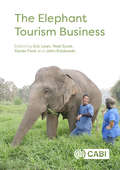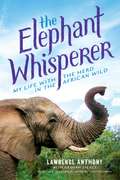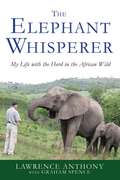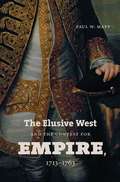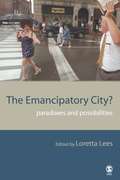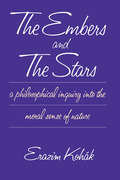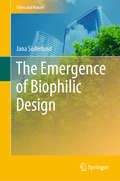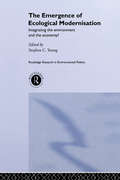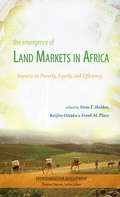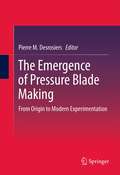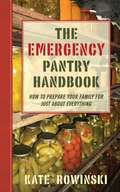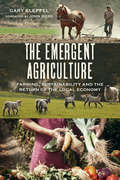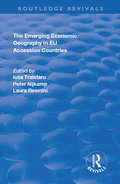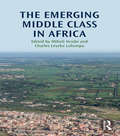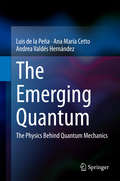- Table View
- List View
The Electrodynamics of Water and Ice (Springer Series in Chemical Physics #124)
by Vasily ArtemovThis book is a research monograph summarizing recent advances related to the molecular structure of water and ice, and it is based on the latest spectroscopic data available. A special focus is given to radio- and microwave frequency regions. Within the five interconnected chapters, the author reviews the electromagnetic waves interaction with water, ice, and moist substances, discussing the microscopic mechanisms behind the dielectric responses. Well-established classic views concerning the structure of water and ice are considered along with new approaches related to atomic and molecular dynamics. Particular attention is given to nanofluidics, atmospheric science, and electrochemistry. The mathematical apparatus, based on diverse approaches employed in condensed matter physics, is widely used and allows the reader to quantitatively describe the electrodynamic response of water and ice in both bulk and confined states. This book is intended for a wide audience covering physicists, electrochemists, geophysicists, engineers, biophysicists, and general scientists who work on the electromagnetic radiation interaction with water and moist substances.
The Electron Mass and Calcium Isotope Shifts
by Florian Köhler-LangesThis thesis presents the first isotope-shift measurement of bound-electron g-factors of highly charged ions and determines the most precise value of the electron mass in atomic mass units, which exceeds the value in the literature by a factor of 13. As the lightest fundamental massive particle, the electron is one of nature’s few central building blocks. A precise knowledge of its intrinsic properties, such as its mass, is mandatory for the most accurate tests in physics - the Quantum Electrodynamics tests that describe one of the four established fundamental interactions in the universe. The underlying measurement principle combines a high-precision measurement of the Larmor-to-cyclotron frequency ratio on a single hydrogen-like carbon ion studied in a Penning trap with very accurate calculations of the so-called bound-electron g-factor. For the isotope-shift measurement, the bound-electron g-factors of two lithium-like calcium isotopes have been measured with relative uncertainties of a few 10^{-10}, constituting an as yet unrivaled level of precision for lithium-like ions.
The Elements Book: A Visual Encyclopedia of the Periodic Table (DK Our World in Pictures)
by DKPacked with more than 1,000 incredible images and full of fascinating facts, this children&’s book takes you on a visual and vibrant journey of all the chemical elements that make up our world. This eye-catching encyclopedia for kids is the perfect guide to the 118 chemical elements of the periodic table, for budding young scientists to explore. It explores the naturally occurring elements, as well as the man-made ones, and explains their properties and uses. This engaging encyclopedia for children aged 9-12, shows the many natural forms of each element, as well as a wide range of both everyday and unexpected objects in which it is found, making each element relevant to the child&’s world!Celebrate your child's curiosity as they explore:- Striking and detailed diagrams, drawings and illustrations on every page- A highly visual approach to learning - Ideal combination of colorful diagrams with infographic text boxes- Showcases chemical elements in their pure and raw forms- In association with The Smithsonian InstitutionThis captivating kids encyclopedia takes a look at all 118 elements on the periodic table, from Hydrogen to Helium, Potassium to Polonium, calcium to carbon and so much more! The striking illustrations, photographs and diagrams featured throughout provide an optimum visual learning experience for both children and adults alike, accompanied by an array of fun facts all about your favorite elements, and lesser-known ones like Terbium, Thallium and Boron - with easy-to-read accessible text for readers aged 9-12, yet can be enjoyed by the entire family, making this enthralling children&’s encyclopedia a beautiful and educational gift that can be passed down generations.Learn all about the world one picture at a time!If you like The Elements Book then why not complete the collection? Part of the highly visual Our World In Pictures series, avid readers can dive into the world of dinosaurs with The Dinosaur Book, become a vehicle virtuoso with Cars, Trains, Ships and Planes and venture on a journey across the globe with Countries, Cultures, People & Places.
The Elements We Live By: How Iron Helps Us Breathe, Potassium Lets Us See, and Other Surprising Superpowers of the Periodic Table
by Anja RøyneWINNER OF THE 2018 BRAGE PRIZE'[T]his lovely book. An enjoyable sweep through topics ranging from respiration to space exploration -solid science presented in an engagingly human way' Andrew Crumey, author of The Great Chain of Unbeing'Perfect popular science . . . not just a well-written story about the elements, but a book about being human in the world today'Åsmund H. Eikenes, author of Splash: A History of Our BodiesWe all know that we depend on elements for survival - from oxygen in the air we breathe to carbon in the molecular structures of all living things. But we seldom appreciate how, say, phosphorus holds our DNA together or how potassium powers our optic nerves enabling us to see.Physicist and award-winning author Anja Røyne takes us on an astonishing journey through chemistry and physics, introducing the building blocks from which we humans - and everything else in the world - are made. Not only does Røyne explain why our bodies need iron, phosphorus, silicon, potassium and many more elements in just the right amounts in order to function, she also shows us where in the world these precious elements are found (some of them in limited and quickly depleting quantities).Røyne helps us understand how precariously balanced our lives - and ways of living - really are, and to appreciate little known and generally unsung heroes of the periodic table in an entirely new light.
The Elements We Live By: How Iron Helps Us Breathe, Potassium Lets Us See, and Other Surprising Superpowers of the Periodic Table
by Anja RøyneWINNER OF THE 2018 BRAGE PRIZE'[T]his lovely book. An enjoyable sweep through topics ranging from respiration to space exploration -solid science presented in an engagingly human way' Andrew Crumey, author of The Great Chain of Unbeing'Perfect popular science . . . not just a well-written story about the elements, but a book about being human in the world today'Åsmund H. Eikenes, author of Splash: A History of Our BodiesWe all know that we depend on elements for survival - from oxygen in the air we breathe to carbon in the molecular structures of all living things. But we seldom appreciate how, say, phosphorus holds our DNA together or how potassium powers our optic nerves enabling us to see.Physicist and award-winning author Anja Røyne takes us on an astonishing journey through chemistry and physics, introducing the building blocks from which we humans - and everything else in the world - are made. Not only does Røyne explain why our bodies need iron, phosphorus, silicon, potassium and many more elements in just the right amounts in order to function, she also shows us where in the world these precious elements are found (some of them in limited and quickly depleting quantities).Røyne helps us understand how precariously balanced our lives - and ways of living - really are, and to appreciate little known and generally unsung heroes of the periodic table in an entirely new light.
The Elements of Architecture: Principles of Environmental Performance in Buildings
by Scott DrakeThe Elements of Architecture is a clear and well structured introduction to sustainable architecture, which concentrates on general principles to make an accessible and comprehensive primer for undergraduate students. The author takes a fresh and logical approach, focusing on the way aspects of the built environment are experienced by the occupants and how that experience is interpreted in architectural design. He works through basic elements and senses (sun; heat; light; sound; air; water and fire) to explain and frame effective environmental architectural design - not only arguing that the buildings we inhabit should be viewed as extensions of our bodies that interact with and protect us from these elements, but also using this analogy to explain complex ideas in an accessible manner.
The Elements of Environmental Pollution
by John RieuwertsEnvironmental pollution is one of humanity’s most pressing issues and will remain so for the foreseeable future. Anthropogenic activity is disturbing natural cycles and generating pollutants that are altering the atmosphere, accumulating in the food chain and contaminating the world’s soils, rivers and oceans. Human health and ecosystems continue to be damaged by toxic metals, persistent organic pollutants, radionuclides and other hazardous materials. The Elements of Environmental Pollution provides comprehensive coverage of this essential subject. It explains the key principles of pollution science, assesses human disturbances of natural element cycles and describes local and global pollution impacts, from smoggy cities, polluted lakes and toxic soils to climate change, ocean acidification and marine dead zones. The book is informed by the latest pollution research and benefits from numerous real-world examples and international case studies. A comprehensive glossary provides clear and concise explanations of key concepts. This textbook will support teaching and learning in environment-related university courses and will be vital reading for anyone with an interest in environmental protection.
The Elements of Power
by David S. AbrahamOur future hinges on a set of elements that few of us have even heard of. In this surprising and revealing book, David S. Abraham unveils what rare metals are and why our electronic gadgets, the most powerful armies, and indeed the fate of our planet depend on them. These metals have become the building blocks of modern society; their properties are now essential for nearly all our electronic, military, and "green" technologies. But their growing use is not without environmental, economic, and geopolitical consequences. Abraham traces these elements' hidden paths from mines to our living rooms, from the remote hills of China to the frozen Gulf of Finland, providing vivid accounts of those who produce, trade, and rely on rare metals. He argues that these materials are increasingly playing a significant role in global affairs, conferring strength to countries and companies that can ensure sustainable supplies. Just as oil, iron, and bronze revolutionized previous eras, so too will these metals. The challenges this book reveals, and the plans it proposes, make it essential reading for our rare metal age.
The Elephant Tourism Business
by Eric Laws Anja Pabel Rebecca Winkler Clive Phillips Eric Brymer Andrew McLean Professor Noel Scott Melville Saayman Daniel Turner Professor Xavier Font Mucha Mkono Ann Suwaree Ashton Liv Baker Sumanth Bindumadhav Sarah Blaine Naphawan Chantradoan Saranphat Chotmanakul Qingming Cui Susanna Curtin Charlotte Day Nilakshi Galahitiyawe Vivek Gurusamy Nicole Hausler Jeffrey Dale Hobbs Claire Jenkinson Professor John Koldowski Naut Kusters Shilpa Mahbubani Somyot Ongkhluap Piengpen Na Pattalung Kannapa Pongponrat Bongkosh Rittichainuwat John Edward Roberts Andrea Saayman Jan Schmidt-Burbach Alokparna Sengupta Vinathe Sharma-Brymer Ramona Strödecke Daminda Sumanapala Marjorie Van Strein Isabelle Wolf Honggang XuElephant tourism is a growing activity in many countries across Asia and Africa and is popular with tourists from all parts of the world. Elephant tourism has grown rapidly, providing the only viable way for elephants and their owners to survive since the banning of logging. Old logging camps have been developed into sanctuaries for some elephants, but many other camps were established as entertainment centres, resulting in serious welfare issues for the elephants and their mahouts. The profits from elephant tourism in Asia have encouraged African operators to follow a similar business model. This book draws attention to the need for a comprehensive and rigorous focus on local solutions to improve the welfare of captive elephants, their mahouts and local residents, and to enhance tourists' experiences of elephant tourism. It achieves this by: - Critically reviewing recent research into elephant tourism. - Providing contemporary analytical case studies of elephant tourism policy and practice. The Elephant Tourism Business will contribute to a better understanding of how elephant tourism is organised, regulated and promoted, both in elephant areas and tourist origin countries. It identifies priorities for future research into elephant tourism and provides a unique, authoritative resource for researchers, elephant managers and administrators, and tourism managers. The book will be of interest to academics and practitioners with backgrounds in conservation, the environment, tourism and veterinary sciences, and will appeal to tourists keen to experience elephants in person.
The Elephant Whisperer (Young Readers Adaptation): My Life with the Herd in the African Wild
by Thea Feldman Lawrence Anthony Graham SpenceWhen Lawrence Anthony was asked to accept a rogue herd of elephants in his reserve in South Africa, it was the last chance for these elephants. If Anthony didn’t take them, they would be shot. But he had no experience with elephants at all. What was he to do?Take them on, of course!What follows is an exciting and heartwarming series of adventures, in which Anthony learns about elephants and becomes part of their family. Full of both triumph and tragedy, this fascinating account of living with the majestic elephant is unforgettable.
The Elephant Whisperer: My Life With the Herd in the African Wild
by Lawrence Anthony Graham SpenceLawrence Anthony devoted his life to animal conservation, protecting the world's endangered species. Then he was asked to accept a herd of "rogue" wild elephants on his Thula Thula game reserve in Zululand. His common sense told him to refuse, but he was the herd's last chance of survival: they would be killed if he wouldn't take them. In order to save their lives, Anthony took them in. In the years that followed he became a part of their family. And as he battled to create a bond with the elephants, he came to realize that they had a great deal to teach him about life, loyalty, and freedom. The Elephant Whispereris a heartwarming, exciting, funny, and sometimes sad memoir of Anthony's experiences with these huge yet sympathetic creatures. Set against the background of life on an African game reserve, with unforgettable characters and exotic wildlife, Anthony's unrelenting efforts at animal protection and his remarkable connection with nature will inspire animal lovers and adventurous souls everywhere.
The Elephants Come Home: A True Story of Seven Elephants, Two People, and One Extraordinary Friendship
by Kim TomsicThe amazing true story of a herd of elephants, the man who saved them, and the miracle of love that brought them home.One day in 1999, Lawrence Anthony and Françoise Malby hear that a herd of wild African elephants need a new home. They welcome the elephants to their wildlife sanctuary—Thula Thula—with open arms. But the elephants are much less sure they want to stay. How will Lawrence prove to them that they are safe and loved? What follows is a gorgeously illustrated real-life story of a friendship . . . and the story of the miraculous way that love given freely will return—greater and more wonderful than it began.• TOUCHING ANIMAL FRIENDSHIPS: Owen and Mzee, Tarra and Bella, Rescue and Jessica . . . touching true stories of the emotional bonds possible between species are charming, and speak to the limitlessness of love.• ELEPHANT APPEAL: Elephants are one of the most fascinating and charming wild animals in all of nature. This heartwarming true story will intrigue and inspire children, and turn even the most reluctant readers into elephant enthusiasts.• CONSERVATION THEME: This book tells the true story of caring for one of the world's most beloved endangered animals: the African elephant. This book is a great, upbeat jumping-off point for discussions of the importance of preserving endangered species and their environments.• ENGAGING NONFICTION: There's no better way to get readers hooked on factual books than to offer them real-life stories with heart and meaning.• STRONG CURRICULUM CONNECTIONS: The Next Generation Science Standards (NGSS) emphasize learning about animal habitats/biomes in K–2 curriculums, while later grades address topics like conservation and endangered species. With a depth of research and an engaging, highly visual narrative, this book is an excellent resource for librarians and primary school educators.Perfect for:• Kindergarten and elementary school teachers• Parents and grandparents• Librarians• Lovers of animals, wildlife, and the natural world• Zoo and natural history museumgoers
The Elusive West and the Contest for Empire, 1713-1763
by Paul W. MappA truly continental history in both its geographic and political scope, The Elusive West and the Contest for Empire, 1713-1763 investigates eighteenth-century diplomacy involving North America and links geographic ignorance about the American West to Europeans' grand geopolitical designs. Breaking from scholars' traditional focus on the Atlantic world, Paul W. Mapp demonstrates the centrality of hitherto understudied western regions to early American history and shows that a Pacific focus is crucial to understanding the causes, course, and consequences of the Seven Years' War.
The Emancipatory City?: Paradoxes and Possibilities
by Loretta Lees'The Emancipatory City is a wonderful addition to a growing literature on the public culture of the city. In these spaces, tolerance and intolerance, difference and indifference, transgressions, resistances, and playful spontaneity erupt to give texture to urban life. The book broadens our gaze and deepens our understanding of how cities enable people to express themselves and be free' - Robert A Beauregard, New School University, New York Who are cities for? What kinds of societies might they most democratically embody? And, how can cities be emancipatory sites? The ambivalent status of urban space in terms of emancipation, democratisation, justice and citizenship is central to recent work in urban geography, `new' cultural geography, critical geography and postmodern planning, as well as literature on urban social justice, public space and the politics of identity. Seeking alternative and progressive visions of the emancipatory city through an exploration of the tensions and possibilities between the freedoms and constraints offered by the city, the authors of The Emancipatory City? build on this wealth of current perspectives to present an critical analysis of urban experience.
The Embers and the Stars: A Philosophical Inquiry into the Moral Sense of Nature
by Erazim Kohák"It is hard to put this profound book into a category. Despite the author's criticisms of Thoreau, it is more like Walden than any other book I have read. . . . The book makes great strides toward bringing the best insights from medieval philosophy and from contemporary environmental ethics together. Anyone interested in both of these areas must read this book."—Daniel A. Dombrowski, The Thomist "Those who share Kohák's concern to understand nature as other than a mere resource or matter in motion will find his temporally oriented interpretation of nature instructive. It is here in particular that Kohák turns moments of experience to account philosophically, turning what we habitually overlook or avoid into an opportunity and basis for self-knowledge. This is an impassioned attempt to see the vital order of nature and the moral order of our humanity as one."—Ethics
The Emergence of Biophilic Design (Cities and Nature)
by Jana SöderlundThis book addresses the emergence of biophilic design, a form of design that looks at people’s intrinsic connection with nature. There is no denying that biophilic design is rapidly expanding globally as an effective response to pressing issues in urban areas and built environments. From being a term few had heard of in 2012, when the author’s research began, to one that is currently trending in a broad range of disciplines, the story of its emergence has never been properly told. The story of the emergence of biophilic design is the story of a social movement and how a gathering of people with a common interest and passion can spark a global trend. The book and the stories within are not only engaging but also informative and educational, offering readers an in-depth understanding of what biophilic design is all about, and how to promote its implementation in their own built environment. Hopefully, they will inspire people to act, to campaign and to implement initiatives in their urban environment, with the confidence that they are capable of making a difference. The author spent three years researching the emergence of biophilic design, and why and how it was driven by certain people who championed the concept. Part of the author’s research involved a three-month tour of ten North American cities, during which she interviewed 26 key players. These people ranged from community leaders, landscape architects, and academics, to the CEOs of NGOs and government leaders. The result is a collection of stories that illustrate the evolution of biophilic design, and how it was frequently born from a passion for, belief in and love of nature, as well as a response to an urban crisis.
The Emergence of Ecological Modernisation: Integrating the Environment and the Economy? (Environmental Politics #1)
by Stephen C. YoungThe Emergence of Ecological Modernisation offers a wealth of empirical research material from an international perspective, bringing together previously scattered sources for the first time. It addresses a series of theoretical issues that are of key contemporary relevance, such as the relationship between ecological modernisation and sustainable development; strategies for promoting ecological modernisation, and the extent to which it is possible to 'green' contemporary capitalism.
The Emergence of Land Markets in Africa: Impacts on Poverty, Equity, and Efficiency (Environment for Development)
by Keijiro Otsuka Stein T. Holden Frank M. PlaceThis book is the first systematic attempt to address emerging land markets and their implications for poverty, equity, and efficiency across a number of African countries. The high incidence of poverty and the need for increased agricultural productivity remain acute in rural areas of sub-Saharan Africa, where a lack of secure land rights and a growing scarcity of land relative to the size of the population are becoming increasingly critical issues. Indeed, land issues in the region are high on the international policy agenda. Yet our knowledge about land tenure security and other rural factor markets (such as labor, oxen, manure, purchased inputs, and credit) is far from adequate to formulate sensible policies. The case studies in the book show that, while land markets and especially informal markets have been rapidly emerging in densely populated parts of Africa - and have generally been to the benefit of the poor--their functions remain imperfect. This is due to policy-induced tenure insecurity and the fragmentation of agricultural land. Applying rigorous quantitative analyses, the book provides a basis for taking into account the role of land markets in national land policies. All too often, the authors argue, land policies have been extreme, either prohibiting all land transactions or giving unrestricted freehold rights to a small elite at the expense of the poor. From the long experience in Asia, it is known that such policies are detrimental to both production efficiency and equity of land use. The authors argue that future policies in Africa should work with the markets. Regulations should be imposed only with careful testing that they are having the intended effects. The Emergence of Land Markets in Africa is a resource for teaching in developed and developing countries, as it provides both comprehensive reviews of the literature and detailed case studies. It is intended to facilitate the dialogue between researchers and policymakers, as well as inspire researchers to go further in their investigations and build an even stronger basis for good policies. The Emergence of Land Markets in Africa is the first publication in the new Environment for Development (EfD) book series. EfD books focus on research and applications in environmental and natural resource economics as they are relevant to poverty reduction and environmental problems in developing countries. The EfD book series is part of the EfD initiative. (www.environmentfordevelopment.org)
The Emergence of Pressure Blade Making
by Pierre M. DesrosiersHuman development is a long and steady process that began with stone tool making. Because of this skill, humans were able to adapt to climate changes, discover new territories, and invent new technologies. "Pressure knapping" is the common term for one method of creating stone tools, where a larger device or blade specifically made for this purpose is use to press out the stone tool. Pressure knapping was invented in different locations and at different points in time, representing the adoption of the Neolithic way of life in the Old world. Recent research on pressure knapping has led for the first time to a global thesis on this technique. The contributors to this seminal work combine research findings on pressure knapping from different cultures around the globe to develope a cohesive theory. This contributions to this volume represents a significant development to research on pressure knapping, as well as the field of lithic studies in general. This work will be an important reference for anyone studying the Paleolithic, Mesolithic, and Neolithic periods, lithic studies, technologies, and more generally, cultural transmission.
The Emergency Pantry Handbook: How to Prepare Your Family for Just about Everything
by Kate Rowinski Jim RowinskiIn today’s world, anything can happen—medical emergencies, power outages, natural disasters. In less time than it takes to sign off on an insurance form, the world as we know it can be brought to a standstill. There can be no question: It’s best to be prepared. The Emergency Pantry Handbook by cooking expert and readiness enthusiast Kate Rowinski offers tips, techniques, and advice on how to keep your family safe, well-fed, and fully supplied in the event of any crisis. With simple instructions, Rowinski demonstrates how to create an emergency strategy; how to protect your house, documents, and keepsakes; and how to prepare for specific disasters. Offering a unique twist on preparation handbooks, Rowinski focuses on food storage and cooking—put simply, how to plan nutritional emergency meals and avoid “making due” on canned meats and chocolate bars. The Emergency Pantry Handbook details:· Storage techniques · Personalizing your food plan · Stockpiling, shelf life, and rotation · Pickling, canning, sprouting, and drying · Making delicious dinners out of your storage pantry Whether a disaster lasts for twenty-four hours or twenty-four weeks, The Emergency Pantry Handbook is the ultimate guide to keeping your family eating healthily and maintaining proper nutrition, even in the worst of circumstances.
The Emergent Agriculture
by Gary Kleppel John IkerdLong embraced by corporations who are driven only by the desire for profit, industrial agriculture wastes precious resources and spews millions of tons of greenhouse gases into the atmosphere each year, exacerbating climate change and threatening the very earth and water on which we depend. However, this dominant system, from which Americans obtain most of their food, is being slowly supplanted by a new paradigm.The Emergent Agriculture is a collection of fourteen thematic essays on sustainability viewed through the lens of farming. Arguing that industrial food production is incompatible with the realities of nature, science, and ethics, this lyrical narrative makes the case for a locally based food system which is: Stable in the face of economic uncertainty Resilient in the face of environmental variability Grounded in stewardship of the land, on attaching value to food and the craft involved in producing it, and on respecting the dignity of farmers, consumer,s and livestockA revolution in food production is underway. Written from the vantage point of an ecologist who is also a farmer, The Emergent Agriculture is essential reading for anyone interested in food security and the potential for growing local economies. Food for thought about the future of food.Gary Kleppel is a professor of biology at the SUNY Albany, where he focuses on sustainable agriculture, conservation-based grazing, and the ecology of human-dominated landscapes. He and his wife Pam are owners of Longfield Farm, where they produce grass-fed lamb, wool, free range chickens and eggs, and artisanal breads.
The Emerging Economic Geography in EU Accession Countries (Routledge Revivals)
by Peter NijkampThis title was first published in 2003. Since 1990, Central and Eastern European countries have experienced increased economic integration with the European Union. The spatial implications of this process have been little investigated so far. Have patterns of regional specialization and industrial concentration changed during the 1990s? How does regional specialization relate to economic performance? How has access to Western markets affected the regional wage structure? What types of regions are winners and what types of regions are losers? This book poses and answers such policy relevant questions. It is organized into three parts. The first introduces the main features of economic integration and transition processes in Central and Eastern Europe and discusses the theoretical and methodological framework of the research. The second part examines the cases of five countries: Bulgaria, Estonia, Hungary, Romania and Slovenia, and the final part includes three comparative analyses which explain the underlying factors that determine the changing patterns of location of manufacturing activity, the adjustment pattern of regional wages and adaptation processes in border regions in the five countries.
The Emerging Middle Class in Africa
by Mthuli Ncube Charles Leyeka LufumpaThe emergence of the African middle class as a driver of Africa’s economic growth stands out as an important milestone in Africa’s contemporary economic history. This growth, though uneven, is a source of hope for Africa, but also a signal to the rest of the world on the prospects for economic recovery and renewal, particularly because it has been steady despite the global downturn. The Emerging Middle Class in Africa analyses specific aspects of the lives of the middle class in Africa. It looks at how people become and remain in the middle class through a series of thematic chapters. It examines how behaviour changes in the process, in terms of consumption patterns and spending on health and education. A further dimension of this analysis is how class impacts on gender relations and whether women are able to reap the same benefits of social advancement available to men. Africa is a continent of such scale and diversity that experiences across countries vary widely. The book thus captures the common patterns across the continent. This text is primarily aimed at Africanist researchers, policy makers, development practitioners, and bilateral and multilateral institutions, as well as students of African studies, political science, political economy, development studies, and development economics.
The Emerging Quantum
by Luis de la Peña Ana María Cetto Andrea Valdés HernándezThis monograph presents the latest findings from a long-term research project intended to identify the physics behind Quantum Mechanics. A fundamental theory for quantum mechanics is constructed from first physical principles, revealing quantization as an emergent phenomenon arising from a deeper stochastic process. As such, it offers the vibrant community working on the foundations of quantum mechanics an alternative contribution open to discussion. The book starts with a critical summary of the main conceptual problems that still beset quantum mechanics. The basic consideration is then introduced that any material system is an open system in permanent contact with the random zero-point radiation field, with which it may reach a state of equilibrium. Working from this basis, a comprehensive and self-consistent theoretical framework is then developed. The pillars of the quantum-mechanical formalism are derived, as well as the radiative corrections of nonrelativistic QED, while revealing the underlying physical mechanisms. The genesis of some of the central features of quantum theory is elucidated, such as atomic stability, the spin of the electron, quantum fluctuations, quantum nonlocality and entanglement. The theory developed here reaffirms fundamental scientific principles such as realism, causality, locality and objectivity.
